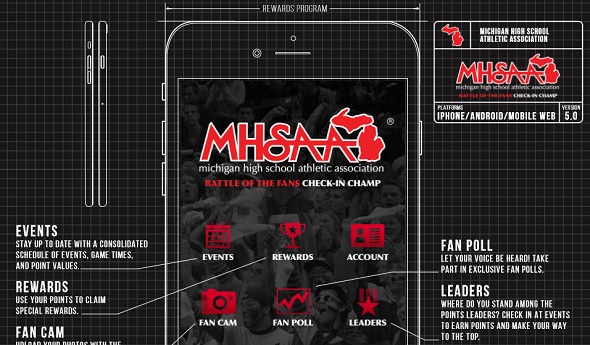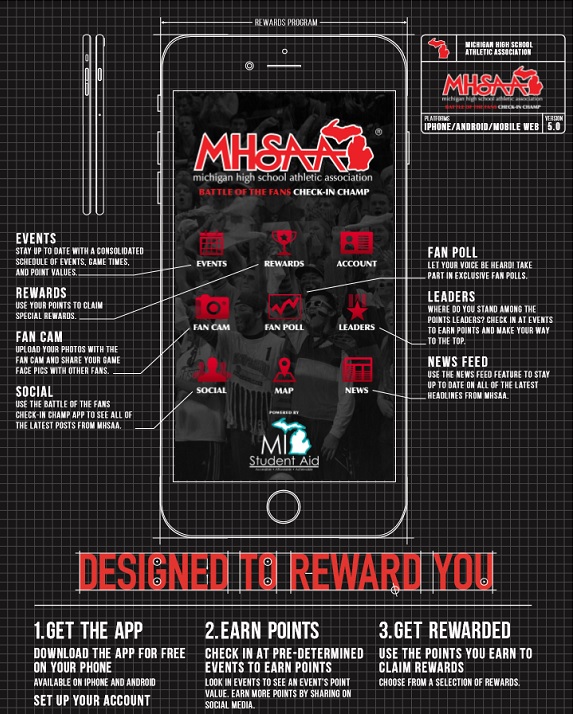
'Check-in Champ' App Rewards Fans
January 10, 2017
By Geoff Kimmerly
Second Half editor
The Michigan High School Athletic Association and SuperFanHigh, a leading fan loyalty and engagement company, have launched a mobile app that will allow students, faculty, alumni, community members and all fans to earn prizes and college scholarships by showing support for high school basketball teams.
To participate, fans simply need to download the “Check-in Champ” app for free from the Apple iTunes or Google Play online stores and then check in at high school girls and boys basketball games they are attending this season. SuperFanHigh will track these check-ins and provide standings of fans who attend the most events statewide beginning Tuesday, Jan. 10. Fans “checking in” accrue points toward prizes including a total of $5,000 in college scholarships sponsored by MI Student Aid.
“The ‘Check-in Champ’ contest provides an exciting opportunity for our schools to promote their regular-season girls and boys basketball games,” MHSAA Executive Director John E. “Jack” Roberts said. “We’re eager to see how this will build more excitement at games, both during the regular season and the MHSAA tournament, and we’re appreciative of MI Student Aid for adding significant incentive for students and their families who support their classmates and communities.”
For the remainder of this Michigan high school boys and girls basketball season, fans who attend games will earn points. When registering on the app, fans must select their favorite school. Schools will be divided by Class: A, B, C and D. A $3,000 scholarship will be awarded to the fan who earns the most points overall across all four classes, and $500 scholarships will be awarded to fans who earn the most points in each class.
Only student fans will be eligible to use the college scholarships; however, fans who are not students may still compete for the scholarships and designate them for specific students should they win the contest. All fans, including those who are not students, will be able to earn app “badges” as they accrue points, and the top 100 point-getters will receive shirts printed to celebrate their accomplishment in the contest.
“We are excited about partnering with the MHSAA to launch this new app,” said Anne Wohlfert, Director of the Student Financial Services Bureau at the Michigan Department of Treasury. “We are pleased to offer $5,000 in scholarship dollars to the students who attend the most games. This joint venture aligns with our goals to provide high school students and their families with student financial resources and information.”
The app provides other information for students and fans including their selected schools’ boys and girls basketball team schedules, MHSAA news and an opportunity to share photos through a ‘fan cam.’ Participants may accrue bonus points by answering MHSAA basketball trivia questions and promoting their “check-ins” on social media.
SuperFanHigh is a division of its parent company, SuperFanU and provides fan experiences for more than 300 high schools and colleges/universities across the country. The company is leading the market in developing innovative platforms that allow the communication and marketing between students/fans and schools to be more engaging and efficient.
“We know that our partnership with MHSAA will yield lots of excitement this year across the state of Michigan,” says Kayla Mount, co-founder and COO of SuperFanU.


Preliminary Concussion Data Announced
December 9, 2015
By Geoff Kimmerly
Second Half editor
The Michigan High School Athletic Association this school year requested for the first time that member schools report possible concussions by their student-athletes during both practice and competition. Preliminary data from the fall season shows two percent of more than 100,000 high school athletes experienced concussions, and 27 percent of high schools responding reported that none of their athletes experienced concussions while participating in MHSAA sports.
The MHSAA received data from 744 – or 99 percent – of its member high schools at the end of the fall season. The average number of concussions reported by member high schools through Dec. 4, 2015, was 3.2 concussions per school. Fifty-two percent of reporting schools stated they had two or fewer concussions by athletes this fall.
Football, the fall season’s most-played sport with 39 percent of all fall participants, revealed 79 percent of all concussions reported for the season. Boys soccer, with nearly 14 percent of fall sport participants, revealed 11 percent of all concussions reported.
Data collected by the MHSAA remains preliminary, in part, because results noted include pending reports that have not been verified. After completion of these follow-up reports, the final number of concussions that actually occurred this past season may be lower than the preliminary numbers being reported at this time. The data analyzed to date is for high schools only, although middle schools also have the opportunity to report possible concussions. A full breakdown of the data including concussions by gender, sport, team level (varsity through junior high) and setting (practice or event) will be reported after the conclusion of the spring 2016 season.
The reporting of possible concussions is part of a three-pronged advance by the MHSAA in concussion care during the 2015-16 school year, all of which are producing data related to the frequency and severity of head injuries. The MHSAA this fall became the first state association to offer pilot sideline concussion testing, with 62 schools taking part in one of two programs. One of the objectives of the pilot programs was to increase awareness of concussions and improve sideline detection; and preliminary results indicate that the average number of possible concussions reported by pilot schools exceeds the average reported by schools outside the pilot group.
Of 36 schools reporting the most concussions this fall, 11 are part of the MHSAA’s pilot sideline detection programs. Those programs – King-Devick Test and XLNTbrain Sport – utilize technology to provide on-site testing of athletes who have sustained possible concussions, with results of those examinations then compared against baseline tests taken by athletes previously.
The MHSAA also is the first state association to provide all participants at every member high school and junior high/middle school with insurance intended to pay accident medical expense benefits – covering deductibles and co-pays left unpaid by other policies – resulting from head injuries sustained during school practices or competitions and at no cost to either schools or families. The program will produce additional data about the frequency and severity of head injuries. While it is still early, only 34 claims have been made on the insurance policy designed to assist in payment for concussion care. Twenty of the claims are for football, 11 for soccer.
“These three efforts combined are part of making our good programs better,” MHSAA Executive Director John E. “Jack” Roberts said. “We’re pleased to provide these services to our schools, and we anticipate having a comprehensive report after the end of the school year, with that data then used by the National Federation of State High School Associations and research institutions to continue to make our games safer.”
Schools report possible concussions online via the MHSAA Website. Reports are then examined by members of the MHSAA staff, who follow up with school administrators as those student-athletes continue to receive care and eventually return to play. Student privacy is protected.
Previously, the MHSAA also was among the first state associations to adopt a return-to-play protocol that keeps an athlete out of activity until at least the next day after a suspected concussion, and allows that athlete to return to play only after he or she has been cleared for activity by a doctor (M.D. or D.O.), physician’s assistant or nurse practitioner.
“These pilot programs, and the reporting of potential concussions by all of our schools, have made administrators, coaches and athletes more aware of the possibility of concussions and the importance of immediate detection and care,” Roberts said. “Many of our schools have long had programs in place to detect concussions and provide care. The opportunities to test, report and receive financial assistance in the event of a concussion have encouraged all of our schools to consider additional ways to better care for their student-athletes.
“These latest in a long line of health and safety initiatives will establish a baseline, and eventually allow us to determine if we are making progress year-to-year in Michigan school sports in this critical area of health and safety.”
The MHSAA is a private, not-for-profit corporation of voluntary membership by more than 1,400 public and private senior high schools and junior high/middle schools which exists to develop common rules for athletic eligibility and competition. No government funds or tax dollars support the MHSAA, which was the first such association nationally to not accept membership dues or tournament entry fees from schools. Member schools which enforce these rules are permitted to participate in MHSAA tournaments, which attract more than 1.4 million spectators each year.

